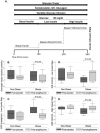Insulin sensitizing and anti-inflammatory effects of thiazolidinediones are heightened in obese patients
- PMID: 24141239
- PMCID: PMC3933072
- DOI: 10.2310/JIM.0000000000000017
Insulin sensitizing and anti-inflammatory effects of thiazolidinediones are heightened in obese patients
Abstract
Objective: The American Diabetes Association has called for further research on how patients' demographics should determine drug choices for individuals with type 2 diabetes mellitus (T2DM). Here, using in-depth physiology studies, we investigate whether obese patients with T2DM are likely to benefit from thiazolidinediones, medications with a known adverse effect of weight gain.
Materials and methods: Eleven obese and 7 nonobese individuals with T2DM participated in this randomized, placebo-controlled, double-blind, crossover study. Each subject underwent a pair of "stepped" pancreatic clamp studies with subcutaneous adipose tissue biopsies after 21 days of pioglitazone (45 mg) or placebo.
Results: Obese subjects demonstrated significant decreases in insulin resistance and many adipose inflammatory parameters with pioglitazone relative to placebo. Specifically, significant improvements in glucose infusion rates, suppression of hepatic glucose production, and whole fat expression of certain inflammatory markers (IL-6, IL-1B, and inducible nitric oxide synthase) were observed in the obese subjects but not in the nonobese subjects. Additionally, adipose tissue from the obese subjects demonstrated reduced infiltration of macrophages, dendritic cells, and neutrophils as well as increased expression of factors associated with fat "browning" (peroxisome proliferator-activated receptor gamma coactivator-1α and uncoupling protein-1).
Conclusions: These findings support the efficacy of pioglitazone to improve insulin resistance and reduce adipose tissue inflammation in obese patients with T2DM.
Figures

Similar articles
-
Pioglitazone improves glucose metabolism and modulates skeletal muscle TIMP-3-TACE dyad in type 2 diabetes mellitus: a randomised, double-blind, placebo-controlled, mechanistic study.Diabetologia. 2013 Oct;56(10):2153-63. doi: 10.1007/s00125-013-2976-z. Epub 2013 Jun 30. Diabetologia. 2013. PMID: 23811853 Clinical Trial.
-
Anti-inflammatory effects of troglitazone in nondiabetic obese subjects independent of changes in insulin sensitivity.Neth J Med. 2005 Jul-Aug;63(7):250-5. Neth J Med. 2005. PMID: 16093575 Clinical Trial.
-
Restoration of adipose function in obese glucose-tolerant men following pioglitazone treatment is associated with CCAAT enhancer-binding protein β up-regulation.Clin Sci (Lond). 2012 Aug 1;123(3):135-46. doi: 10.1042/CS20110662. Clin Sci (Lond). 2012. PMID: 22309242 Clinical Trial.
-
Peroxisome proliferator-activated receptor-γ (PPAR-γ) agonists on glycemic control, lipid profile and cardiovascular risk.Curr Mol Pharmacol. 2012 Jun;5(2):272-81. doi: 10.2174/1874467211205020272. Curr Mol Pharmacol. 2012. PMID: 22122457 Review.
-
Insulin resistance and its treatment by thiazolidinediones.Recent Prog Horm Res. 2001;56:265-94. doi: 10.1210/rp.56.1.265. Recent Prog Horm Res. 2001. PMID: 11237217 Review.
Cited by
-
Diabetes and Sepsis: Risk, Recurrence, and Ruination.Front Endocrinol (Lausanne). 2017 Oct 30;8:271. doi: 10.3389/fendo.2017.00271. eCollection 2017. Front Endocrinol (Lausanne). 2017. PMID: 29163354 Free PMC article. Review.
-
Is the risk of cardiovascular disease altered with anti-inflammatory therapies? Insights from rheumatoid arthritis.Clin Transl Immunology. 2016 May 20;5(5):e84. doi: 10.1038/cti.2016.31. eCollection 2016 May. Clin Transl Immunology. 2016. PMID: 27350883 Free PMC article. Review.
-
Early Clinical Detection of Pharmacologic Response in Insulin Action in a Nondiabetic Insulin-Resistant Population.Curr Ther Res Clin Exp. 2015 Aug 14;77:83-9. doi: 10.1016/j.curtheres.2015.08.001. eCollection 2015 Dec. Curr Ther Res Clin Exp. 2015. PMID: 26543510 Free PMC article.
-
Obesity: An Immunometabolic Perspective.Front Endocrinol (Lausanne). 2016 Dec 12;7:157. doi: 10.3389/fendo.2016.00157. eCollection 2016. Front Endocrinol (Lausanne). 2016. PMID: 28018292 Free PMC article. Review.
-
Rosiglitazone remodels the lipid droplet and britens human visceral and subcutaneous adipocytes ex vivo.J Lipid Res. 2019 Apr;60(4):856-868. doi: 10.1194/jlr.M091173. Epub 2019 Feb 19. J Lipid Res. 2019. PMID: 30782959 Free PMC article.
References
-
- Alessi MC, Bastelica D, Morange P, et al. Plasminogen activator inhibitor 1, transforming growth factor-beta1, and BMI are closely associated in human adipose tissue during morbid obesity. Diabetes. 2000;49:1374–1380. - PubMed
-
- Coppack SW. Pro-inflammatory cytokines and adipose tissue. The Proceedings of the Nutrition Society. 2001;60:349–356. - PubMed
-
- Hotamisligil GS, Spiegelman BM. Tumor necrosis factor alpha: a key component of the obesity- diabetes link. Diabetes. 1994;43:1271–1278. - PubMed
-
- Griffin ME, Marcucci MJ, Cline GW, et al. Free fatty acid-induced insulin resistance is associated with activation of protein kinase C theta and alterations in the insulin signaling cascade. Diabetes. 1999;48:1270–1274. - PubMed
Publication types
MeSH terms
Substances
Grants and funding
- R56 DK069861/DK/NIDDK NIH HHS/United States
- UL1 TR000086/TR/NCATS NIH HHS/United States
- DK-48321/DK/NIDDK NIH HHS/United States
- KL2 TR000088/TR/NCATS NIH HHS/United States
- TL1RR000087/RR/NCRR NIH HHS/United States
- R01 DK048321/DK/NIDDK NIH HHS/United States
- KL2TR000088/TR/NCATS NIH HHS/United States
- TL1 TR000087/TR/NCATS NIH HHS/United States
- R01 DK069861/DK/NIDDK NIH HHS/United States
- P60 DK020541/DK/NIDDK NIH HHS/United States
- R37 DK048321/DK/NIDDK NIH HHS/United States
- UL1TR000086/TR/NCATS NIH HHS/United States
- DK-069861/DK/NIDDK NIH HHS/United States
- RR 12248/RR/NCRR NIH HHS/United States
- UL1 TR001073/TR/NCATS NIH HHS/United States
- P30 DK020541/DK/NIDDK NIH HHS/United States
- DK-20541/DK/NIDDK NIH HHS/United States
- M01 RR012248/RR/NCRR NIH HHS/United States
LinkOut - more resources
Full Text Sources
Other Literature Sources
Medical
Research Materials

